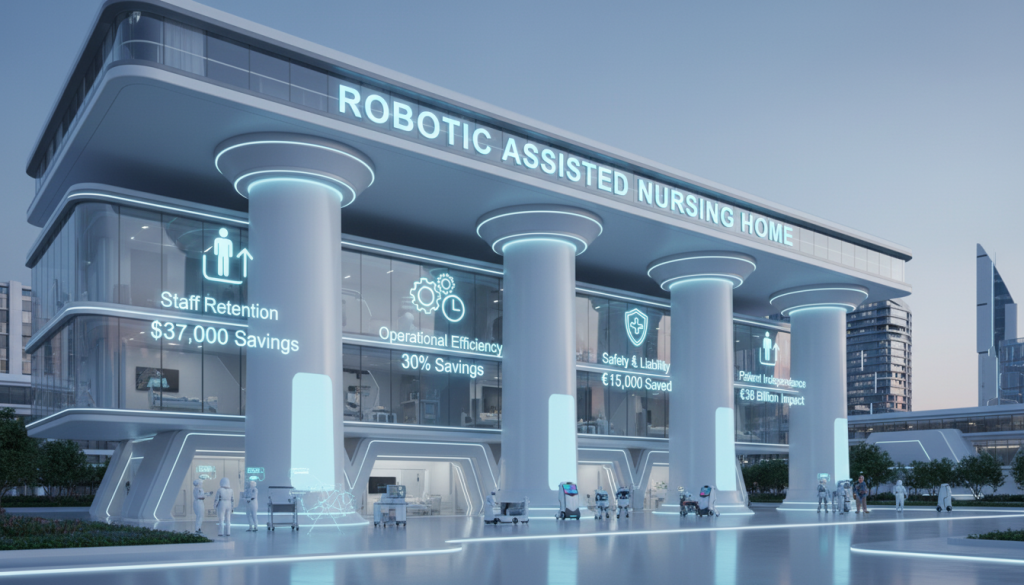
DOMINATE the Market: 4 Strategic Reasons to Invest in a Robotic Assisted Nursing Homes Now
The Fiscal Reality: The Cost of Waiting is No Longer Affordable
Robotic assisted nursing homes are no longer a luxury but a necessity. The financial sustainability of long-term care is breaking under the weight of manual inefficiency. The overall economic burden of neurological events like stroke across Europe exceeds €60 billion annually, with costs rising due to an aging population. This expense is compounded by a staff crisis where replacing a single specialized healthcare professional can cost up to 200% of the employee’s yearly salary.
Robotic Assisted Nursing Homes are the only model that addresses both sides of the balance sheet: dramatically reducing operational expenditures while simultaneously unlocking new revenue streams through superior clinical performance. Investing in Robotic Assisted Nursing Homes is the strategic pivot that secures financial dominance.

4 Strategic Reasons to Invest: Money Spent vs. Money Saved by Automation
The adoption of integrated robotics moves costs from the “Liability” column to the “Asset” column.
1. Operational Efficiency: Eliminating Wasteful Labor Costs (nursing home automation)
The core drain on nursing home budgets is human labor dedicated to repetitive, non-clinical tasks. Nursing home automation directly solves this by cutting down on avoidable expenses.
-
Turnover Reduction: The cost of replacing a Registered Nurse in the US averages about $37,000. Automation reduces physical strain and burnout—a major factor in staff exodus—by taking over the exhausting repetition of Robotic assisted Ergotherapy. Reducing staff turnover by just 5% significantly boosts cash flow.
-
Administrative Savings: Across the healthcare sector, automation holds a potential for 36% of activities to be automated. By offloading administrative and logistical tasks (like those handled by TrollyBot), Robotic Assisted Nursing Homes gain cost savings of up to 30% within five years in back-office and service activities.
2. Revenue Generation: Maximizing Throughput and Reimbursement (Robotic assisted Occupational therapy)
In value-based reimbursement systems, objective data and efficiency are directly tied to revenue.
-
Data-Driven Reimbursement: Unlike subjective charting, Robotic assisted Occupational therapy systems (like ErgoBot) provide objective, quantifiable data (ROM, force, speed) that strengthens documentation, demonstrates medical necessity, and reduces reimbursement denials. This maximizes revenue realization from payers.
-
Increased Throughput: By using technology to monitor and guide therapy, a skilled therapist can oversee multiple patients simultaneously, leveraging Robotic assisted rehabilitation. This increased patient volume, or throughput, without an increase in payroll, generates immediate revenue growth.
3. Risk Mitigation: Cutting Down High-Cost Liability (Robotic assisted rehabilitation)
Robotic Assisted Nursing Homes technology acts as an insurance policy against devastating, high-cost liabilities, providing a clear ROI on safety.
-
Fall & Hospitalization Costs: The cost of long-term nursing home care in the EU-27 was €21 billion in 2021, and these costs escalate rapidly after major incidents. AI-driven monitoring (PhysioEye) reduces the risk of falls and subsequent hospitalizations, which carry an average cost exceeding $15,000.
-
Informal Care Burden: Stroke costs Europe €38 billion in unpaid informal care. Robotic assisted rehabilitation accelerates patient recovery and functional independence in seniors, reducing the dependency on high-cost institutional care and the reliance on family (informal care), appealing directly to families concerned with total cost of care.
4. Market Leadership: Attracting Premium Patients and Staff (Robotic assisted Ergotherapy)
Investing in advanced Robotic assisted Ergotherapy provides a competitive edge that justifies higher rates and attracts top talent.
Attracting Talent: By eliminating burnout-inducing manual labor, Robotic Assisted Nursing Homes become a destination employer, saving high turnover costs. Lower attrition leads to better patient outcomes and satisfaction, which in turn influences Value-Based Purchasing payments.
Premium Positioning: Being known as the best-equipped center for Robotic assisted rehabilitation attracts patients with private insurance and cash-pay clients seeking guaranteed outcomes, providing a revenue stream less dependent on fluctuating government reimbursement schedules.
The Path Forward: nursing home automation is the Standard
The financial evidence is conclusive. Every minute spent on manual tasks or lost due to high turnover is a direct attack on profitability. Robotic assisted rehabilitation—from the precise treatment delivered by ErgoBot to the logistical power of nursing home automation—is the essential tool for any executive seeking to ensure market DOMINANCE and long-term financial health while guaranteeing functional independence in seniors.
